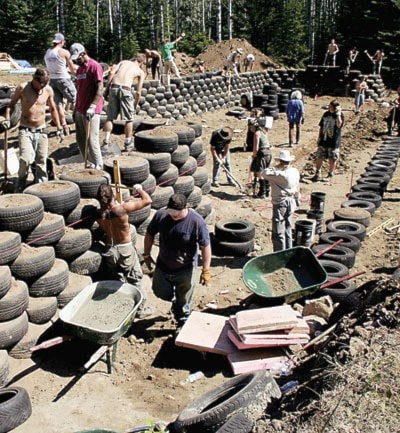Last month, the South Cariboo Sustainability Society (SCSC) presented a movie documentary, called Garbage Warrior, which told the story of architect Michael Reynolds and his proven concept of radically sustainable housing.
His designs are fully functional and off the conventional power grid, made from recycled materials and powered by the sun and wind. Called Earthships, they collect the household water from rain and snow, grow food and have a sanitary sewage treatment system.
The movie attracted an audience of 25 people, and on Nov. 22, the SCSC will host a couple of slideshow presentations on building Earthships and feature two local women, Linda Halls and Monica Holy, who have hands-on experience with them.
Halls built her own recently under the direction of Reynolds' crew members and with the help of Holy and nearly 40 volunteers who came from all over the world for the experience.
Halls notes that with the professional help, construction costs were comparable to that of conventional housing but energy cost savings in the future will be the payback.
The general concept of an Earthship dictates back and side walls are constructed of recycled tires packed with earth and are insulated on the outside with earth berms, which reach to roof level.
The tires create thermal mass, which absorbs heat when it is available and slowly releases it during cooler times.
The front wall, which is made entirely of glass, faces south and is part of a narrow greenhouse space that runs the length of the building. Heat comes from the sun through the glass and is dispersed throughout the house. It makes the house capable of maintaining a temperature of about 21 C throughout the year, with no alternative heat.
Solar panels in front also charge batteries, which supply all of the necessary energy to run the usual appliances one would find in a conventional house.
Water supply is addressed with large cisterns sunk in the ground that collect rain and snow melted with heat tubes, from the roof. An intensive filtering system purifies the water.
Grey water is returned to the greenhouse and is recycled several times before making its way to a regular septic tank. The greenhouse is also capable of growing food all year long.
Typically, the interior walls in an Earthship are finished with plaster or concrete for an adobe effect and partition walls can be constructed with glass bottles or tin cans and held together with mortar.
"It can be left entirely up to the imagination on how to finish a house," Holy says, adding that from the inside, it's not easy to distinguish an Earthship design from a conventionally built home.
She plans to build an Earthship in the near future and has been involved in the construction of two.
"It's the alternative structure that makes perfect sense. We are trying to create awareness of what is out there."
The presentation takes place on Nov. 22 at 7:30 p.m. at the 100 Mile House Branch Library meeting room.
